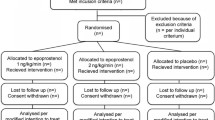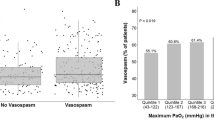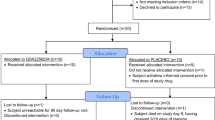Abstract
Background
Subarachnoid hemorrhage (SAH) is a neurological emergency. Delayed ischemic neurological deficit is one of the main causes of poor outcome after SAH and is probably caused, at least in part, by cerebral vasospasm. The pathophysiology of this is multifaceted, but endothelial damage and activation as well as glycocalyx damage have been implicated. Prostacyclin has been shown to protect damaged and activated endothelium and to facilitate glycocalyx repair. We investigated biomarkers of endothelial activation and damage in patients with SAH randomized to 5 days prostacyclin infusion or placebo.
Methods
Patients with aneurysmal SAH managed by coiling or surgery, and a World Federation of Neurological Surgeons score between 1 and 4, and Fisher grade 3 or 4, were treated with a continuous low-dose intravenous prostacyclin infusion or placebo initiated on day 5 and discontinued on day 10 after SAH. Blood samples were drawn from the patients before, during and after prostacyclin/placebo infusion. Soluble biomarkers of endothelial cell activation (sE-selectin, sVE-cadherin) and damage (sTM), glycocalyx damage (syndecan-1) and sympathoadrenal activation (adrenaline, noradrenaline), were measured by ELISA.
Results
Ninety patients were randomized. Prostacyclin infusion influenced neither biomarkers of sympathoadrenal activation, endothelial activation and damage nor biomarkers of endothelial glycocalyx breakdown.
Conclusions
We did not find any effects on markers of sympathoadrenal activation, endothelial damage and activation, or glycocalyx degradation of delayed onset prostacyclin infusion compared to placebo. Further trials investigating early onset endothelial repair using prostacyclin are warranted.

Similar content being viewed by others
References
Annecke T, Fischer J, Hartmann H, Tschoep J, Rehm M, Conzen P, Sommerhoff CP, Becker BF (2011) Shedding of the coronary endothelial glycocalyx: effects of hypoxia/reoxygenation vs ischaemia/reperfusion. Br J Anaesth 107:679–686
Fink K, Schwarz M, Feldbrugge L, Sunkomat JN, Schwab T, Bourgeois N, Olschewski M, von Zur MC, Bode C, Busch HJ (2010) Severe endothelial injury and subsequent repair in patients after successful cardiopulmonary resuscitation. Crit Care 14:R104
Frijns CJ, Kasius KM, Algra A, Fijnheer R, Rinkel GJ (2006) Endothelial cell activation markers and delayed cerebral ischaemia in patients with subarachnoid haemorrhage. J Neurol Neurosurg Psychiatry 77:863–867
Grande PO, Lundgren A, Bjartmarz H, Cronqvist M (2010) Segmental cerebral vasoconstriction: successful treatment of secondary cerebral ischaemia with intravenous prostacyclin. Cephalalgia 30:890–895
Holmvang L, Ostrowski SR, Dridi NP, Johansson P (2012) A single center, open, randomized study investigating the clinical safety and the endothelial modulating effects of a prostacyclin analog in combination with eptifibatide in patients having undergone primary percutaneous coronary intervention (PCI) for ST-segment elevation myocardial infarction. Prostaglandins Other Lipid Mediat 99:87–95
Johansson PI, Mortensen CR, Nielsen T, Tollund C, Stensballe J, Hansen CP, Frederiksen HJ, Ostrowski SR (2016) The effect of intraoperative and 6-h postoperative intravenous administration of low-dose prostacyclin on the endothelium, hemostasis, and hemodynamics in patients undergoing a pancreaticoduodenoctemy: a randomized-controlled pilot study. Eur J Gastroenterol Hepatol. doi:10.1097/MEG.0000000000000800
Johansson PI, Stensballe J, Rasmussen LS, Ostrowski SR (2012) High circulating adrenaline levels at admission predict increased mortality after trauma. J Trauma Acute Care Surg 72:428–436
Kolias AG, Sen J, Belli A (2009) Pathogenesis of cerebral vasospasm following aneurysmal subarachnoid hemorrhage: putative mechanisms and novel approaches. J Neurosci Res 87:1–11
Koskinen LO, Olivecrona M, Rodling-Wahlstrom M, Naredi S (2009) Prostacyclin treatment normalises the MCA flow velocity in nimodipine-resistant cerebral vasospasm after aneurysmal subarachnoid haemorrhage: a pilot study. Acta Neurochir (Wien) 151:595–599
Kozniewska E, Michalik R, Rafalowska J, Gadamski R, Walski M, Frontczak-Baniewicz M, Piotrowski P, Czernicki Z (2006) Mechanisms of vascular dysfunction after subarachnoid hemorrhage. J Physiol Pharmacol 57(Suppl 11):145–160
Loch MR (2006) Management of cerebral vasospasm. Neurosurg Rev 29:179–193
Ostrowski SR, Berg RM, Windelov NA, Meyer MA, Plovsing RR, Moller K, Johansson PI (2013) Coagulopathy, catecholamines, and biomarkers of endothelial damage in experimental human endotoxemia and in patients with severe sepsis: a prospective study. J Crit Care 28:586–596
Ostrowski SR, Henriksen HH, Stensballe J, Gybel-Brask M, Cardenas JC, Baer LA, Cotton BA, Holcomb JB, Wade CE, Johansson PI (2016) Sympathoadrenal activation and endotheliopathy are drivers of hypocoagulability and hyperfibrinolysis in trauma: a prospective observational study of 404 severely injured patients. J Trauma Acute Care Surg. doi:10.1097/TA.0000000000001304
Ostrowski SR, Pedersen SH, Jensen JS, Mogelvang R, Johansson PI (2013) Acute myocardial infarction is associated with endothelial glycocalyx and cell damage and a parallel increase in circulating catecholamines. Crit Care 17:R32
Page AV, Liles WC (2013) Biomarkers of endothelial activation/dysfunction in infectious diseases. Virulence 4:507–516
Park KW, Metais C, Dai HB, Comunale ME, Sellke FW (2001) Microvascular endothelial dysfunction and its mechanism in a rat model of subarachnoid hemorrhage. Anesth Analg 92:990–996
Penn DL, Witte SR, Komotar RJ, Sander Connolly E Jr (2015) Pathological mechanisms underlying aneurysmal subarachnoid haemorrhage and vasospasm. J Clin Neurosci 22:1–5
Rasmussen R, Wetterslev J, Stavngaard T, Juhler M, Skjoth-Rasmussen J, Grande PO, Olsen NV (2015) Effects of prostacyclin on cerebral blood flow and vasospasm after subarachnoid hemorrhage: randomized, pilot trial. Stroke 46:37–41
Rasmussen R, Wetterslev J, Stavngaard T, Skjoth-Rasmussen J, Grande PO, Olsen NV, Romner B (2012) The effects of continuous prostacyclin infusion on regional blood flow and cerebral vasospasm following subarachnoid haemorrhage: study protocol for a randomised controlled trial. Trials 13:102
van Ierssel SH, Conraads VM, Van Craenenbroeck EM, Liu Y, Maas AI, Parizel PM, Hoymans VY, Vrints CJ, Jorens PG (2015) Endothelial dysfunction in acute brain injury and the development of cerebral ischemia. J Neurosci Res 93:866–872
Zemke D, Farooq MU, Mohammed YA, Majid A (2007) Delayed ischemia after subarachnoid hemorrhage: result of vasospasm alone or a broader vasculopathy? Vasc Med 12:243–249
Acknowledgements
We acknowledge the technical assistance of Marie Helena Stjernkvist and Mehwish Jubeen Hussain for analysis of biomarkers in this study.
The trial was funded by the Copenhagen University Hospital research fund, a non-profit organization with no influence on the trial protocol, conduct or analysis.
Author information
Authors and Affiliations
Corresponding author
Ethics declarations
Ethical standards
This study has been approved by the Danish Ethical Committee on Human Research (ref. no. H-1-2011-087), the Danish Medicines Agency (EudraCT 2011–002798-5), and registered on clinicaltrials.gov (ref. no. NCT01447095), and it has therefore been performed in accordance with the ethical standards laid down in the 1964 Declaration of Helsinki and its later amendments.
All patients gave their informed consent prior to their inclusion in the study.
Conflicts of interest
The authors declare that they have no conflicts of interest.
Additional information
Clinical Trials Registration, Unique Indentifier: NCT01447095
Rights and permissions
About this article
Cite this article
Gybel-Brask, M., Rasmussen, R., Stensballe, J. et al. Effect of delayed onset prostacyclin on markers of endothelial function and damage after subarachnoid hemorrhage. Acta Neurochir 159, 1073–1078 (2017). https://doi.org/10.1007/s00701-017-3168-2
Received:
Accepted:
Published:
Issue Date:
DOI: https://doi.org/10.1007/s00701-017-3168-2




